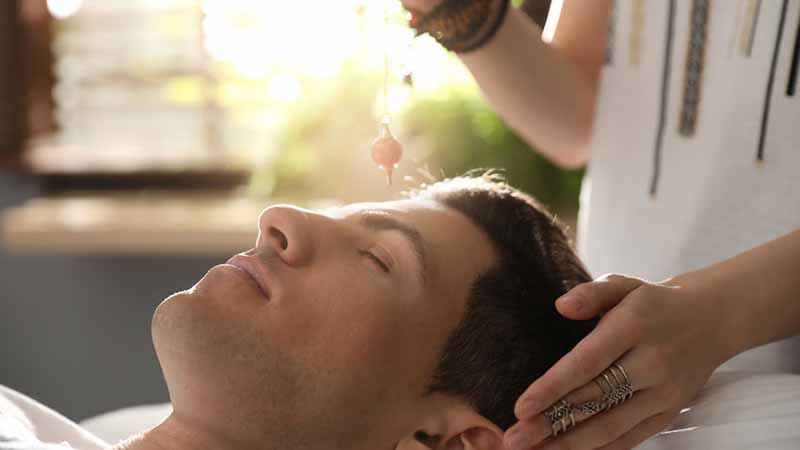
More spas are offering touchless therapies to accommodate needs for physical distancing. Here’s scientific evidence to support their use.
As we continue to navigate the COVID-19 pandemic, the spa, wellness and hospitality world has been adopting touchless guest experiences. Many people want to travel, enjoy self-care, and take part in wellness without the traditional high-touch element. Companies are rising to meet this demand with contactless options for guests.
Among these are spa treatments and therapies, and other wellness experiences that allow people to keep their distance from others while enhancing health and wellbeing.
These include reiki, vibrational sound healing, and forest bathing, aka shinrin yoku. Guests may be less familiar with these modalities than more traditional touch therapies, like massage and hands-on body work, but that doesn’t mean they don’t work. Here is a roundup of scientific evidence demonstrating the potential benefits of three touchless therapies: reiki, sound healing, and shinrin yoku.
Reiki
A form of energy healing that originated in Japan, reiki is one of the best known touchless therapies. It does not involve touch and is said to work through the transfer of universal energy when the practitioner holds their palms over the recipient. The word comes from the Japanese words “rei” (universal) and “ki” (life energy) and stems from a phrase meaning “mysterious atmosphere, miraculous sign.” The belief is that stagnant energy is associated with physical illness and emotional pain and reiki improves the energy flow, improving relaxation, reducing pain, speeding healing, and more.
Reiki has many advocates and is increasing in popularity. Reiki techniques include centering, clearing, and extracting harmful energies.
Scientific evidence
A review of available clinical studies found “reasonably strong” evidence that Reiki is more effective than placebo.” The authors wrote, “Reiki is a safe and gentle ‘complementary’ therapy that activates the parasympathetic nervous system to heal body and mind. It has potential for broader use in management of chronic health conditions, and possibly in postoperative recovery.”
In a 2011 study, subjects who received Reiki demonstrated greater health and mood benefits than those who did not. Separate research found that participants with high anxiety and/or depression who received six, blind 30-minute sessions over a two to eight weeks showed progressive improvement in overall mood, while no change was seen in the controls. Another study found that reiki acutely improved physical and psychological symptoms associated with many health conditions, including pain, depression, anxiety, tiredness, drowsiness, nausea, shortness of breath, appetite, and overall well-being. The authors wrote: “Reiki can provide immediate relief for many health conditions and is used for this purpose inside and outside of the hospital setting.”
Sound healing
Sound healing is a practice that uses voice or sacred instruments like gongs, Tibetan singing bowls, and tuning forks to create vibrational sounds believed to alter brain waves, release energetic blockages, and induce states of ease and harmony. Advocates believe it can relieve ailments like anxiety and insomnia, synchronize brain waves, and restore vibratory frequencies of cells.
Gong Master Martha Collard of Red Doors Studio told Destination Deluxe that sound can shift frequencies “from low energy of guilt and fear to higher vibrations of love and joy.” Malbert Lee, a Hong Kong-based Crystal Bowl and Gong Master, explained, “The adult body is 75% water, and water is a great conductor for sound vibration.”
Scientific evidence
A 2017 study found that subjects who participated in Tibetan singing bowl meditation reported significantly lower tension, anger, fatigue, and depressed mood. Interestingly, “participants who were previously naïve to this type of meditation experienced a significantly greater reduction in tension compared with participants experienced in this meditation.” Feelings of spiritual well-being also significantly increased.
Another 2017 study found that the use of low-frequency sound stimulation resulted in a statistically and clinically relevant improvement in Fibromyalgia symptoms and that subjects showed no adverse effects. Study author Lee Bartel told the Globe and Mail that the most appealing aspects of sound therapy are that it’s low cost, can be administered almost anywhere, and doesn’t have the failure rates or side effects of medications.
“It is something that people can do easily,” he said. “In the future, if we continue to see positive results, the medical community may start prescribing it.”
Forest bathing (shinrin yoku)
Like reiki, forest bathing originated in Japan. It is the simple practice of mindfully immersing oneself in nature. “shinrin” means forest and “yoku” means bath. It’s described as simply being in nature and connecting with nature through sight, hearing, taste, smell and touch.
Scientific evidence
A review of 28 papers found that forest bathing activities might improve cardiovascular function and blood pressure and have a positive impact on metabolism, immunity and inflammation. The research noted significant enhancement of emotional state and alleviation of anxiety and depression, and concluded that forest bathing may significantly improve physical and psychological health.
Separate research found that middle-aged Tokyo office workers who walked in a forest setting were significantly less anxious, slept better, and slept longer than when they walked in a non-forest setting. Interestingly, afternoon walks were more beneficial than morning walks.
Finally, a study of 20,000 people found that those who spent two hours a week in green spaces were substantially more likely to report good health and psychological well-being than those who did not. Two hours was the key. The study found there were no benefits for people who didn’t meet that threshold.
It’s time to look into our crystal balls and predict the future for the year ahead. Subscribe to our newsletter and download our special report on the trends we’ll be watching: Nine spa and wellness trends for 2021. Download here.
Spa Executive is published by Book4Time, the leader in guest management, revenue and mobile solutions for the most exclusive spas, hotels, and resorts around the globe. Learn more at book4time.com.




